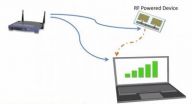(Press-News.org) Imagine a world in which your wristwatch or other wearable device communicates directly with your online profiles, storing information about your daily activities where you can best access it – all without requiring batteries. Or, battery-free sensors embedded around your home could track minute-by-minute temperature changes and send that information to your thermostat to help conserve energy.
This not-so-distant "Internet of Things" reality would extend connectivity to perhaps billions of devices. Sensors could be embedded in everyday objects to help monitor and track everything from the structural safety of bridges to the health of your heart. But having a way to cheaply power and connect these devices to the Internet has kept this from taking off.
Now, University of Washington engineers have designed a new communication system that uses radio frequency signals as a power source and reuses existing Wi-Fi infrastructure to provide Internet connectivity to these devices. Called Wi-Fi backscatter, this technology is the first that can connect battery-free devices to Wi-Fi infrastructure.
"If Internet of Things devices are going to take off, we must provide connectivity to the potentially billions of battery-free devices that will be embedded in everyday objects," said Shyam Gollakota, a UW assistant professor of computer science and engineering. "We now have the ability to enable Wi-Fi connectivity for devices while consuming orders of magnitude less power than what Wi-Fi typically requires."
The researchers will publish their results at the Association for Computing Machinery's Special Interest Group on Data Communication's annual conference this month in Chicago. The team also plans to start a company based on the technology.
This work builds upon previous research that showed how low-powered devices such as temperature sensors or wearable technology could run without batteries or cords by harnessing energy from existing radio, TV and wireless signals in the air. This work takes that a step further by connecting each individual device to the Internet, which previously wasn't possible.
The challenge in providing Wi-Fi connectivity to these devices is that conventional, low-power Wi-Fi consumes three to four orders of magnitude more power than can be harvested in these wireless signals. The researchers instead developed an ultra-low power tag prototype with an antenna and circuitry that can talk to Wi-Fi-enabled laptops or smartphones while consuming negligible power.
These tags work by essentially "looking" for Wi-Fi signals moving between the router and a laptop or smartphone. They encode data by either reflecting or not reflecting the Wi-Fi router's signals, slightly changing the wireless signal. Wi-Fi-enabled devices like laptops and smartphones would detect these minute changes and receive data from the tag.
In this way, your smart watch could download emails or offload your workout data onto a Google spreadsheet.
"You might think, how could this possibly work when you have a low-power device making such a tiny change in the wireless signal? But the point is, if you're looking for specific patterns, you can find it among all the other Wi-Fi reflections in an environment," said co-author Joshua Smith, a UW associate professor of computer science and engineering and of electrical engineering.
The UW's Wi-Fi backscatter tag has communicated with a Wi-Fi device at rates of 1 kilobit per second with about 2 meters between the devices. They plan to extend the range to about 20 meters and have patents filed on the technology.
INFORMATION:
Other co-authors include David Wetherall, a UW professor of computer science and engineering; and Bryce Kellogg and Aaron Parks, both doctoral students in electrical engineering.
The research was funded by the UW Commercialization Gap Fund, the Qualcomm Innovation Fellowship, Washington Research Foundation, the National Science Foundation and the UW.
For more information, contact the research team at iotwifi@cs.washington.edu.
Project website: http://iotwifi.cs.washington.edu/
Related paper: http://iotwifi.cs.washington.edu/files/wifiBackscatter.pdf
Video, photos: http://www.washington.edu/news/2014/08/04/no-power-wi-fi-connectivity-could-fuel-internet-of-things-reality/
No-power Wi-Fi connectivity could fuel internet of things reality
2014-08-04
ELSE PRESS RELEASES FROM THIS DATE:
NASA's IBEX and Voyager spacecraft drive advances in outer heliosphere research
2014-08-04
San Antonio -- Aug. 4, 2014 -- Scientists yesterday highlighted an impressive list of achievements in researching the outer heliosphere at the 40th International Committee on Space Research (COSPAR) Scientific Assembly in Moscow.
"Between NASA's Voyager and IBEX missions, it's an incredible time for outer heliospheric science," says Dr. Dave McComas, IBEX principal investigator and assistant vice president of the Space Science and Engineering Division at Southwest Research Institute, who also will be recognized with a 2014 COSPAR Space Science Award at the assembly. "Ten ...
Children in immigrant families more likely to be sedentary
2014-08-04
Immigrant children from all racial and ethnic backgrounds are more likely to be sedentary than U.S.-born white children, according to a new study by sociologists at Rice University. The researchers said their findings should remind pediatricians and parents of children in immigrant families to encourage physical activity.
The research revealed that children of immigrants from all racial and ethnic backgrounds have lower levels of physical activity than U.S.-born white children, even when adjustments are made for socio-demographic and neighborhood characteristics. A low ...
New tools advance bio-logic
2014-08-04
Researchers at Rice University and the University of Kansas Medical Center are making genetic circuits that can perform more complex tasks by swapping protein building blocks.
The modular genetic circuits engineered from parts of otherwise unrelated bacterial genomes can be set up to handle multiple chemical inputs simultaneously with a minimum of interference from their neighbors.
The work reported in the American Chemical Society journal ACS Synthetic Biology gives scientists more options as they design synthetic cells for specific tasks, such as the production of ...
GW researcher reveals how amphibians crossed continents
2014-08-04
There are more than 7,000 known species of amphibians that can be found in nearly every type of ecosystem on six continents. But there have been few attempts to understand exactly when and how frogs, toads, salamanders and caecilians have moved across the planet throughout time.
Armed with DNA sequence data, Alex Pyron, an assistant professor of biology at the George Washington University, sought to accurately piece together the 300-million-year storyline of their journey.
Dr. Pyron has succeeded in constructing a first-of-its-kind comprehensive diagram of the geographic ...
How should flood risk assessments be done in a changing climate?
2014-08-04
Growing consensus on climate and land use change means that it is reasonable to assume, at the very least, that flood levels in a region may change. Then why, ask Rosner et al. in a new study, do the dominant risk assessment techniques used to decide whether to build new flood protection infrastructure nearly always start with an assumption of "no trend" in flood behavior?
In an argument grounded in an analysis of the inherent limitations of statistical analyses, the authors suggest that researchers' typical starting assumption that flood behavior is not changing—even ...
Insights on whale shark populations and evidence for their historic rise and recent decline
2014-08-04
In the largest study on the genetics of whale sharks conducted to date, researchers found that the world's biggest fish likely exist in 2 distinct populations with minimal connectivity between the Indo-Pacific and the Atlantic Ocean. The findings suggest that mixing of whale sharks between the Indian and Atlantic was and is rare.
The Molecular Ecology investigators also found a significant and likely recent population expansion, but a very recent bottleneck might have gone undetected as genetic diversity at Ningaloo Reef in Australia has declined during 5 consecutive ...
Study assesses shark attacks on Atlantic spotted dolphins near the Bahamas
2014-08-04
A Marine Mammal Science analysis on failed shark attacks on the approximately 120 Atlantic spotted dolphins that are residents of the waters near Bimini, The Bahamas, has found that a total of 14 dolphins (15% of 92 cataloged animals) showed some sign of shark attack, and a further 15 (16%) exhibited scars that could not conclusively be classified as shark induced or not.
Of 14 the shark attacks, there was no difference in scars or wounds between the sexes, and there was no significant difference between the location of bodily scars and wounds. No shark-related injuries ...
Humane strategy reduces shark attacks
2014-08-04
A simple and humane technique may be an effective strategy to reduce human encounters with sharks without harming populations of threatened shark species.
Instead of using advanced (and relatively untested) technology to attempt to repel sharks or nondiscriminatory nets that kill other threatened sea life as bycatch, researchers have simply caught sharks and moved them to where they would not pose a threat to swimmers. The Shark Monitoring Program of Recife, Brazil, reported approximately 100% survival of protected species and a 97% decrease in shark attacks when the ...
Researchers develop food safety social media guide
2014-08-04
To help protect public health, researchers from North Carolina State University have developed guidelines on how to use social media to communicate effectively about food safety.
"In a crisis context, the framework can be used by health officials, businesses or trade organizations affected by foodborne illness to help them reach key audiences with information that could be used to reduce the risk of foodborne illness," says Dr. Ben Chapman, an associate professor at NC State whose research focuses on food safety and lead author of the paper outlining the guidance. Key ...
CU Denver study shows excess parking at some Denver sports stadiums
2014-08-04
DENVER (Aug. 4, 2014) – Sports stadiums in Denver suffer from excess parking, creating unattractive concrete spaces, heat islands, and missed economic opportunities, according to a new study from the University of Colorado Denver.
"We tend to think the more parking, the better," said Wesley Marshall, PhD, PE, assistant professor of civil engineering at the CU Denver College of Engineering and Applied Science. "But too much parking can be as bad as too little."
The study began as a research project for CU Denver engineering student Alejandro Henao and was recently published ...





